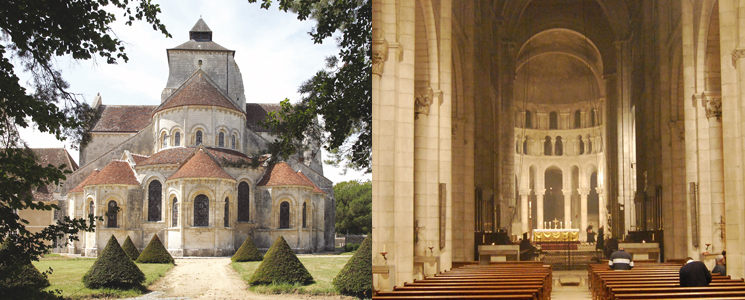Fontgombault Sermon
- All Saints: “I have come to cast fire upon the earth”
Feast of All Saints
Sermon of the Right Reverend Dom Antoine Forgeot
Abbot Emeritus of Our Lady of Fontgombault
Tu solus sanctus.
Thou only art holy
Dear Brothers and Sisters,
Dearly beloved Sons of our Father Abbot,
Today’s solemnity gives us to enter, however little, the heavenly Jerusalem, to contemplate the numberless assembly of all the Saints, and to listen to the songs of praise and worship that they bring up to God and the Lamb.
In other parts of the Apocalypse, St. John makes us hear snatches of the liturgy which is being celebrated before the Throne:
And the four living creatures had each of them six wings: and round about and within they are full of eyes. And they rested not day and night, saying: Holy, Holy, Holy, the Lord God the Almighty, who was and who is and who is to come. (Ap 4:8)
Already at the time of his vocation Isaiah had seen Seraphim standing upon the throne of God and crying unto each other: “Holy, holy, holy, the Lord God of hosts, the whole earth is full of His glory.” (Is 6:3) God is infinitely holy, as the Psalmist sings:
The Lord is great in Zion, and high above all people. Let them give praise to Thy great name: for it is terrible and holy. Exalt ye the Lord our God, and worship at His footstool; for He is holy. (Ps 98 [99]:2.3.5)
God is the source and the model of all holiness. His Son, Our Lord Jesus-Christ, is “the brightness of His glory and the figure of His substance” (Hebr 1:3); it is in Him and through Him that we have access to the Father and that we may glimpse something of His perfection, insofar as He will grant us, insofar also as, under the influence of His grace, we desire it and prepare for it.
It is through the contact with Our Lord, through listening to His teachings and through His imitation that we shall go forward on the path of holiness, to which all of us are called. On several occasions St. Paul invited his correspondents to imitate him as he himself imitated Christ. To the Christians in Ephesus he wrote:
Be ye therefore imitators of God, as dearly beloved children. And walk in love, as Christ also hath loved us and hath given Himself up for us, as a fragrant oblation and a sacrifice to God. (Eph 5:1-2)
In these few words we learn what the essence of holiness is: it is charity, and perfect charity. Charity that goes unto sacrifice of our wealth and our life for the love of God and our neighbour, as so many Christians in the East give us an example even today: they experiment the eighth beatitude, that of those who are persecuted for righteousness’ sake. Let us pray for them, and hail in them the harvest that will not fail to rise, in a Church made fruitful by the blood of so many martyrs; and let us pray God through these martyrs’ intercession to grant us the strength to follow in their footsteps, should we happen to know a similar trial.
If the grace of martyrdom is not everyone’s lot, no one is exempt from following Our Lord’s commandment: “Be you therefore perfect, as also your heavenly Father is perfect.” (Matth 5:48) The programme of holiness has been outlined in the Sermon on the Mount, and precisely in the Beatitudes, in which we can admire the picture of Our Lord Himself. Who indeed has been more than Him poor, meek and merciful? Who more than Him has been reviled, rejected, thirsty for righteousness, and at the same time a peacemaker? And will there ever be a heart more pure and ablaze with love than His Heart?
The path of the Beatitudes is the path that all the Saints have followed in the fervour of good zeal mentioned by St. Benedict, which is nothing else than charity. Pope Benedict XVI, when he still was Cardinal Ratzinger, said in a homily:
Origen handed down to us a word of the Lord: “Whoever is close to me, is close to fire.” He who refuses to be burnt will stand back in fear before Him. The “yes” of Christ’s followers implies the courage to allow ourselves to be burnt by the fire of His Passion, which at the same time is the salvific fire of the Holy Ghost. It is only if we have courage enough to remain near this fire, if we let ourselves be set ablaze, that we shall also be able to set afire the Earth with the fire of life, hope and love. (Fourth Centennial of the Bamberg Seminary, 1986)
Our Lord said: “I have come to cast fire upon the earth; and how I wish it were already kindled!” (Lk 12:49) And St. Paul wrote to the Thessalonicians: “For this is the will of God, your sanctification.” (1 Thess 4:3)
Let us ask Our Lady to make us understand these words and to make us run after her on the path of perfection, so that with her and all the Saints we may forever repeat:
Amen! Benediction and glory and wisdom and thanksgiving, honour and power and strength, to our God, for ever and ever! Amen! (Ap 7:12)





.jpg)






Sem comentários:
Enviar um comentário
Nota: só um membro deste blogue pode publicar um comentário.